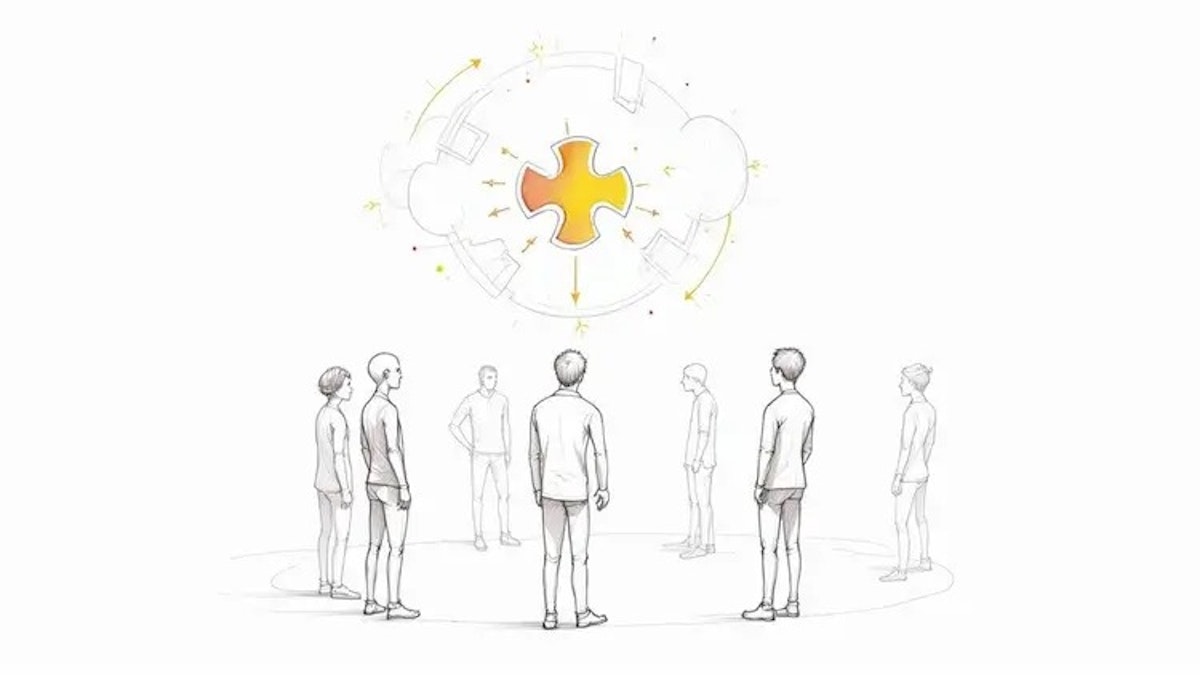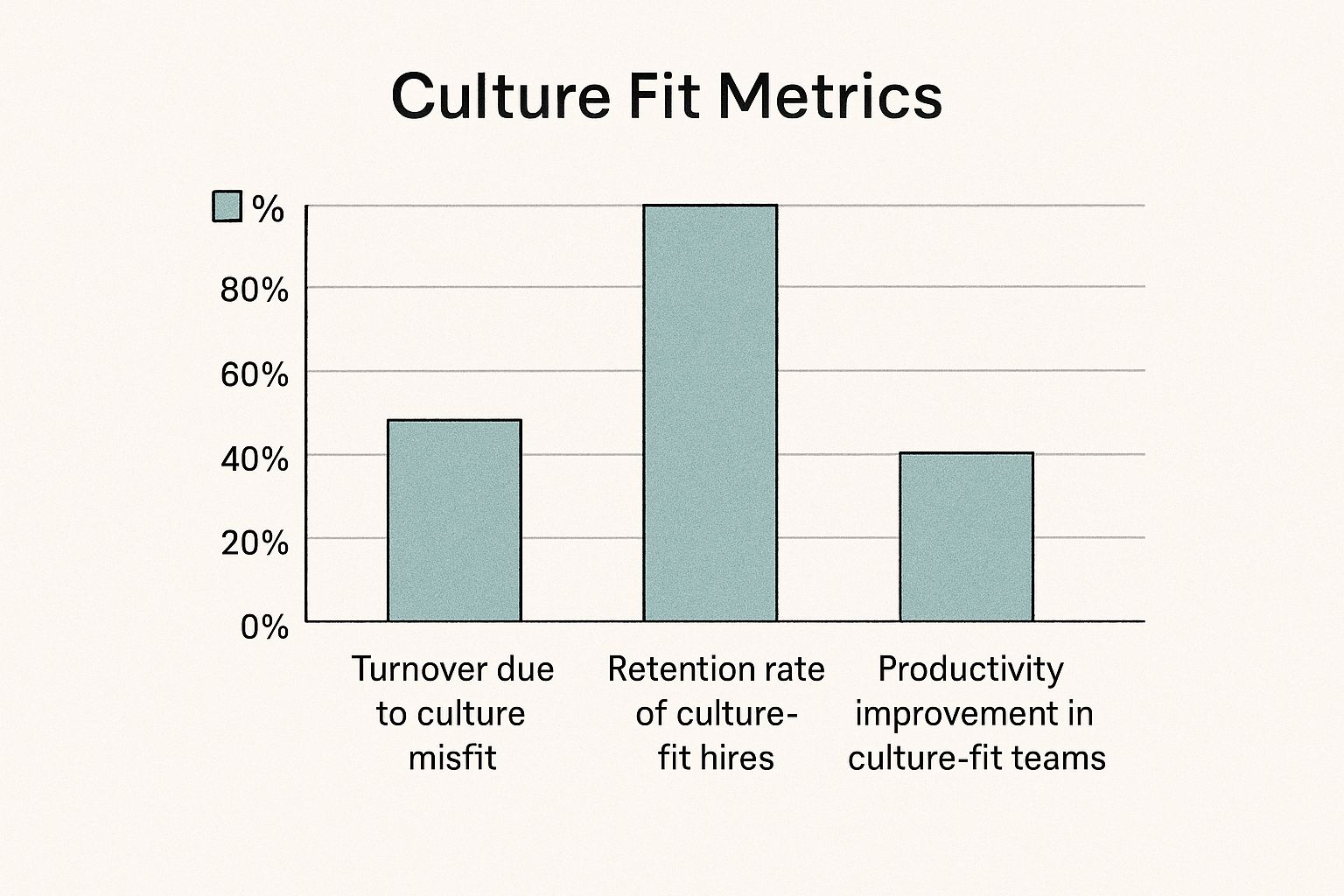A Guide to Hiring for Culture Fit

When we talk about hiring for culture fit, we're really talking about looking past the resume. It's about figuring out if a person's core values, their way of working, and how they behave will genuinely mesh with where your company is headed. The goal isn't just to find someone who can do the job; it's to find someone who will make the whole team better, create a positive vibe, and stick around for the long haul.
Moving Beyond Skills to Strategic Hiring
For years, hiring was pretty simple. You had a job description, and you found a resume that matched. Done. But while skills are obviously critical, the best companies have realized that's only half the story.
Think about it. You could hire a brilliant engineer who does their best work completely alone, headphones on, deep in the zone. But what if your company runs on high-energy, constant collaboration and spontaneous brainstorming sessions? That star engineer is going to be miserable, and the team will feel the friction.
That’s what strategic hiring is all about. It’s not about hiring a bunch of people who look, think, and act the same—that’s a recipe for stagnation. True hiring for culture fit is about building a team of diverse people who are united by a common purpose and a shared set of values, even if they tackle problems from completely different angles.
The Real Cost of a Bad Hire
Getting it wrong—hiring someone who just doesn't fit—is more than just a headache. It’s a serious hit to your bottom line. According to the U.S. Department of Labor, the cost of a bad hire can reach up to 30% of that employee's first-year salary.
Where do those costs come from?
- Recruitment Expenses: All the money and time you poured into job ads, screening resumes, and conducting interviews.
- Lost Productivity: It’s not just that the new person isn't pulling their weight. Their disengagement can drag down the whole team's morale and output.
- Training and Onboarding: Every resource you spent getting them up to speed is just gone when they walk out the door.
- Severance and Replacement: The cost of letting them go and then starting the entire, expensive hiring process all over again.
A report from the Society for Human Resource Management (SHRM) puts an even finer point on it, estimating that turnover due to poor culture fit can cost an organization between 50% and 60% of the person’s annual salary. It’s one of the most expensive mistakes you can make.
Why Strategic Alignment Matters
When you make culture a priority right alongside skills, you're not just filling a seat. You're investing in the future health of your entire organization.
People who feel like they belong are simply better employees. They’re more engaged, they come up with more creative solutions, and they're far more likely to stay. They get the "why" behind their work because it clicks with their own personal values. If you're looking to get clearer on your own company's guiding principles, our guide on the core values of the business is a great place to start.
This becomes especially true when you're growing quickly. It's one thing to hire a few people, but it’s another to be scaling engineering teams without chaos. During rapid expansion, a shared culture is the glue that holds everything together. Nailing this isn’t just a "nice-to-have"—it's a massive competitive advantage that fuels real, sustainable growth.
How to Define Your Company Culture Clearly
 Before you can even think about hiring for culture fit, you need to have a crystal-clear picture of what your culture actually is. Let’s be honest: you can’t assess a candidate against a standard that’s fuzzy or inconsistent in your own mind.
Before you can even think about hiring for culture fit, you need to have a crystal-clear picture of what your culture actually is. Let’s be honest: you can’t assess a candidate against a standard that’s fuzzy or inconsistent in your own mind.
This means you have to get past the aspirational buzzwords on the breakroom poster. Your real culture isn't just what you want it to be; it's the sum of everyday behaviors, communication quirks, and decision-making habits that exist right now. It's how your team actually works together, not how the handbook says they should.
From Vague Values to Tangible Behaviors
Most companies have values like "collaboration," "innovation," or "integrity." On their own, these words are pretty useless for hiring. The trick is to translate them into specific, observable actions. What do these values look like when they’re put into practice on a random Tuesday afternoon?
To get there, start by asking your team some pointed questions:
- When we talk about 'collaboration,' what are we really saying? Does it mean everyone jumps into a spontaneous brainstorm, or does it mean we expect deep, independent work followed by a very structured feedback session?
- What does 'taking initiative' look like around here? Is it drafting a full-blown business case for a new project, or is it just spotting a problem and quietly fixing it without asking for permission?
- How do we deal with failure? Is it a learning opportunity we discuss openly, or is it something everyone tries to avoid at all costs?
The answers you get are the real building blocks of your cultural DNA. They give your hiring managers something concrete to look for in an interview, turning an abstract idea into a measurable quality.
Create Your Culture Manifesto
Once you’ve defined your values with real-world behavioral examples, pull them together into a "Culture Manifesto." Think of this as more than just an internal doc—it's a practical field guide for your entire hiring team. It ensures everyone is measuring candidates against the same yardstick, which is crucial for reducing personal bias and "gut feeling" hires.
Your Culture Manifesto is the constitution for your hiring process. It turns subjective "gut feelings" into an objective, repeatable framework, ensuring that every candidate is evaluated on the same terms.
This manifesto should be a living document, something you revisit and tweak as your company grows and changes. It’s the foundation for writing better job descriptions, crafting smarter interview questions, and ultimately, making much more informed hiring decisions. For more on this, check out our guide on https://www.myculture.ai/blog/building-culture-at-work.
Communication and Collaboration Norms
A massive piece of your culture is simply how people talk to each other and get things done. Are you a Slack-first company where big decisions unfold in real-time in public channels? Or do you lean on formal meetings with detailed agendas and follow-up memos? There’s no right or wrong style, but a mismatch here can create serious friction for a new hire.
Think about these different styles of working:
| Aspect of Work | Style A (e.g., Early-Stage Startup) | Style B (e.g., Established Corporation) |
|---|---|---|
| Pace of Decisions | Fast and iterative, often made with 70% of the info. | Deliberate and data-driven, made after extensive review. |
| Feedback Style | Direct, immediate, and often given publicly in team settings. | Structured, delivered privately in scheduled 1-on-1s. |
| Meeting Culture | Informal, often ad-hoc, with a focus on quick alignment. | Formal, scheduled well in advance, with clear agendas. |
Defining these norms is absolutely critical. Someone who thrives in a highly structured, formal environment is going to feel lost in a place that feels like organized chaos—and the reverse is just as true. Once you've clearly defined these norms, you can improve workplace communication to keep everyone aligned.
Zappos, the online retailer, provides a compelling case study. The company is famous for its ten core values, which include "Deliver WOW Through Service" and "Be a Little Weird." To ensure they hire people who embody these values, Zappos offers new hires $2,000 to quit after their first week of training. Fewer than 1% of people take the offer, demonstrating the effectiveness of a hiring process deeply rooted in cultural alignment.
Weaving Culture into Your Recruitment Process

Alright, you’ve done the hard work and built a Culture Manifesto. Now what? The next step is where the rubber meets the road: actually weaving those values into every single piece of your recruitment journey. Hiring for culture fit isn't a box to check; it's the thread that should run through everything from the first job ad a candidate sees to their final interview with the team.
This is how you turn those abstract values into practical hiring tools. We're moving away from relying on a vague "gut feeling" and toward a deliberate, structured system. Think of it as building a process where each stage gives you a new, clearer picture of how a candidate aligns with the way your team truly works.
Crafting Job Descriptions That Speak Your Language
A job description is your first real chance to make a cultural impression. Too often, they're just a dry list of technical skills and daily tasks. This is a missed opportunity. Your job description should paint a vivid picture of what it’s actually like to work on your team.
Generic job posts attract generic candidates. It’s that simple. To fix this, pull language directly from your Culture Manifesto to signal who will really click with your environment.
Instead of: "Must be a team player."
Try this: "You'll thrive here by jumping into our daily stand-ups, openly sharing your progress in Slack, and giving constructive feedback in our project retrospectives."
Instead of: "Seeking a self-starter."
Try this: "We trust our team to spot challenges and propose solutions. You'll have the autonomy to own your projects from start to finish—with support, not micromanagement."
This kind of specificity does two crucial things. It gets the right people excited about your work style, and just as importantly, it helps those who wouldn't enjoy it to opt out early. That saves everyone a lot of time.
Sourcing Talent from Aligned Channels
Where you look for candidates is just as important as how you talk to them. If "continuous learning" is a core value, it makes sense to source talent from professional development groups, industry forums, or online learning communities.
Ask yourself: where do our ideal future teammates already hang out?
- For a highly collaborative culture: Look for people contributing to open-source projects or speaking at local meetups.
- For a mission-driven culture: Post on job boards that are specifically for non-profits or B-corporations.
- For a deeply creative culture: Engage with talent on platforms like Behance or Dribbble, where their portfolios speak for themselves.
Here's a powerful stat to remember: Glassdoor research found that 77% of job seekers consider a company's culture before they even apply. When you show up in the right places, you're meeting candidates who are already looking for a company just like yours.
The Phone Screen as a Cultural Filter
The initial phone screen is your first live chance to gauge cultural alignment. It's easy to get bogged down in resume details and salary talk, but spending just a few minutes on culture can be incredibly revealing. This isn't a deep dive; it's a quick vibe check.
You can get a lot of information from simple, open-ended questions tied directly to your values:
- "Tell me about a work environment where you felt most productive and engaged. What was it about that place that worked for you?"
- "What's your preferred way of getting feedback on your work?"
- "When you hit a major roadblock on a project, what's usually your first move?"
Their answers give you early clues about whether their working style will mesh with your team's established rhythm. This quick check ensures that the people moving on to the next round are solid on both skills and foundational culture.
Designing Interviews to Test Collaboration
By the time a candidate gets to the team interview, you should already have a good handle on their individual skills. This final stage is the perfect time to see how they actually operate in a group—a cornerstone of hiring for culture fit.
Don't just stick them in front of a panel for a Q&A session. Design an interactive experience.
- Give them a real problem. Present the candidate and a few of your team members with a small, real-world challenge your team has actually tackled recently.
- Observe the dynamics. Now, sit back and watch. Do they listen before they speak? Do they ask smart questions or just jump to conclusions? Do they build on other people's ideas or shut them down?
- Get specific team feedback. After the session, ask your team for behavioral observations. Instead of a generic "Did you like them?", ask "Did you see evidence of our 'radical candor' value in the way they gave feedback?"
This approach changes the interview from a passive performance into an active simulation. It gives you concrete evidence of how they'll actually integrate into your daily workflow, not just how well they answer questions.
Mastering the Culture Fit Interview
Let’s be honest: the interview is where the rubber meets the road. It’s your single best chance to look past a polished resume and really understand who a candidate is—what drives them, how they work, and what they truly value. Getting this right isn't about asking a few generic questions and hoping for the best. It requires a smart, structured approach to uncover real behavioral patterns, not just the answers they think you want to hear.
When you're hiring for culture fit, every question needs to have a purpose. You have to know exactly which cultural attribute you're testing and pick the right kind of question to get an authentic response. This is how you shift from a vague "I have a good feeling about this person" to a confident "I have clear evidence they will thrive on our team."
The business case for this is undeniable. Just look at the hard numbers.

As the data shows, this isn't a "soft" metric. Poor culture fit leads to high turnover, which is a massive, tangible cost. Getting it right directly improves retention and team performance.
Picking the Right Questions for the Job
To get a complete, 360-degree view of a candidate, you need to use a mix of question types. Sticking to just one style will only show you one side of them. The real magic happens when you combine behavioral, situational, and values-based questions. Each one peels back a different layer of a person's professional character.
- Behavioral Questions: These are all about the past. They operate on the proven principle that past behavior is the best predictor of future actions. You’re asking for real-world examples from their career.
- Situational Questions: These look to the future. You present a hypothetical—but realistic—work scenario and ask how they would navigate it.
- Values-Based Questions: These get straight to the point. They dig into a candidate’s personal principles and motivations to see if they genuinely connect with your company’s core values.
The trick is to map these question types to the specific cultural traits you've already defined. For example, if 'autonomy' is a cornerstone of your culture, a situational question about managing a project with minimal oversight is incredibly revealing. For a deeper look at this, our guide on measuring culture fit is a key to successful employee selection offers more detailed strategies.
To effectively assess a candidate's alignment with your company culture, it's crucial to understand how different types of interview questions work. The following table breaks down the most common types, explaining what they assess and providing a clear example for each.
Comparison of Interview Question Types for Assessing Culture Fit
| Question Type | What It Assesses | Example Question |
|---|---|---|
| Behavioral | Past performance and problem-solving in real situations. | "Tell me about a time you made a mistake at work. How did you handle it, and what did you learn from it?" |
| Situational | Future behavior and judgment in hypothetical scenarios. | "Imagine you realize a teammate has been misrepresenting their project's progress to a manager. What would you do?" |
| Values-Based | Personal principles and alignment with company core values. | "What kind of work environment brings out the best in you?" |
Using a strategic mix of these question formats will give your hiring managers a much richer, more reliable picture of each candidate, moving beyond surface-level answers to uncover true cultural compatibility.
Building a Question Library for Key Traits
To make this process consistent and scalable, I always recommend building a question library organized by your core cultural attributes. This takes the guesswork out of interviewing and helps you gather comparable data across all candidates, which is critical for fair and effective decision-making.
Here are a few examples to get you started:
For Assessing "Integrity"
- Behavioral: "Describe a time you had a significant disagreement with a colleague. How did you work through it?"
- Situational: "If you discovered an error in a report that would reflect poorly on your team, but no one else had noticed it yet, what would you do?"
For Assessing "Innovation"
- Behavioral: "Walk me through a time you introduced a new idea or process that was met with resistance. How did you get buy-in?"
- Situational: "If you were given a project with no clear instructions or precedent, what would be your first three steps?"
For Assessing "Collaboration"
- Behavioral: "Tell me about your favorite project you’ve ever worked on as part of a team. What was your role, and what made it so successful?"
- Situational: "You have two high-priority tasks from two different managers, and you can only complete one today. How do you decide what to do?"
When you arm your managers with targeted questions like these, their interviews become dramatically more insightful.
How to Actually Interpret the Answers
Here’s a pro tip: asking the right questions is only half the battle. The real expertise lies in listening and interpreting the answers to spot authentic behavioral patterns. Anyone can deliver a textbook response. You need to listen for consistency, self-awareness, and genuine reflection.
When a candidate answers a behavioral question, listen for the STAR method: Situation (setting the scene), Task (what they needed to do), Action (what they specifically did), and Result (the outcome). A strong answer naturally follows this structure, telling a complete and credible story.
Remember, you're not looking for a single "right" answer. You're looking for an answer that aligns with your specific culture. A candidate who says they’d escalate a conflict to a manager might be a poor fit for a company that expects direct, peer-to-peer resolution.
Research from companies that prioritize this approach shows significant benefits. One well-documented case involved a tech company that integrated structured, culture-based interviews. The result was a reported 30% increase in employee retention and a 25% jump in engagement within the first year, demonstrating a powerful return on investment for a well-run interview process.
Avoiding Common Biases and Pitfalls

Let's be honest: the idea of hiring for culture fit can be a minefield. When you get it right, you create a powerhouse team that’s in sync and driven by the same core values. But get it wrong, and you’ve just created an echo chamber. You end up hiring people who look, think, and act just like everyone else.
This is the fastest path to a homogenous culture, not a resilient one.
The most common trap is confusing genuine cultural alignment with personal affinity. A hiring manager might feel a great "vibe" from a candidate because they share a hobby or went to the same school. That’s not culture fit. That's affinity bias, and it’s a killer for diversity.
Without a structured process built on objective criteria, interviewers will almost always default to what feels comfortable. This often means hiring carbon copies of themselves.
The Critical Shift from Culture Fit to Culture Add
To break this cycle, forward-thinking talent leaders are reframing the entire conversation around "culture add." It’s a subtle but profound shift. You stop asking, "Will this person fit in?" and start asking, "What new perspective or skill can this person bring to make us better?"
Here’s how to think about it:
- Culture Fit is about the non-negotiables. These are your core values—the bedrock principles like integrity, customer obsession, or a strong work ethic that every single person must share.
- Culture Add is about everything else. It’s about actively seeking out diverse backgrounds, unique ways of solving problems, and different life experiences that challenge your team to think bigger.
You absolutely need both. The goal is to find a candidate who fits your core principles while adding a new dimension to your team's collective horsepower. It's this balance that creates a team that is unified in its mission but diverse in its thinking.
When you hire for culture add, you're not watering down your culture; you're future-proofing it. You’re intentionally injecting new perspectives that prevent stagnation and help you navigate whatever comes next.
This isn't just a feel-good idea. Research consistently shows that hiring for cultural alignment while intentionally protecting diversity leads to stronger teams and dramatically lower turnover. A study published in the Journal of Organizational Behavior found that person-organization fit is a significant predictor of both job satisfaction and lower turnover intentions.
Building Guardrails Against Bias
So, how do you make this practical? You build guardrails into your hiring process—systems that force objectivity and dial down the influence of personal bias. This isn't about taking the human element out of hiring; it's about grounding our judgment in consistent, fair criteria.
Here’s how to start.
Use Structured Interview Scorecards
Don’t just "have a chat." Create a scorecard for every role based on your Culture Manifesto. Every interviewer must rate candidates on the exact same set of predefined cultural traits and skills. This forces a direct, evidence-based comparison, sidelining vague "gut feelings."
Assemble Diverse Interview Panels
A single person should never make a hiring decision alone. Your interview panel should be a mix of people from different departments, backgrounds, and levels of seniority. A diverse group of interviewers will naturally spot a wider range of strengths and weaknesses, effectively canceling out each other's blind spots.
Conduct Practical Bias Training
Train your hiring managers to spot the usual suspects: affinity bias, the halo/horn effect (letting one great or terrible trait color everything else), and confirmation bias (looking for evidence to back up a snap judgment). Awareness is the first step. Technology can also give you an edge; you can learn more about reducing hiring bias with AI tools in our article.
By putting these safeguards in place, you ensure your focus on culture fit actually strengthens your organization instead of cloning it. You’re building a team with a solid, shared foundation but with plenty of open windows to let in new ideas.
Answering Your Top Questions About Hiring for Culture Fit
Even with a solid plan in place, moving towards intentionally hiring for culture fit can feel like a big shift. It’s natural for questions and concerns to pop up for everyone involved, from recruiters to hiring managers. Let's tackle some of the most common ones I hear from leaders trying to get this right.
Honestly, one of the biggest hang-ups is just the language we use. I see leaders throw around "culture fit" and "culture add" as if they're the same thing, but they’re not. They are two different sides of the same coin, and you need both to build a team that doesn't just get along but truly innovates.
Culture Fit vs. Culture Add: What’s the Real Difference?
The distinction is all about what you're looking for. "Culture fit" is about aligning with the absolute, non-negotiable foundations of how your company works. Think of your core values and fundamental operating principles. For example, if your culture is built on a bedrock of radical transparency, you need to hire people who are genuinely comfortable with giving and receiving direct, open feedback. These are the table stakes—the elements that allow someone to slot into your team and start contributing without major friction.
Then you have "culture add." This is where you get strategic. Culture add is about identifying what’s missing from your team and actively seeking it out in a candidate. This could be a different professional background, a novel way of looking at problems, or a fresh perspective that comes from a completely different life experience. Purposefully hiring for culture add is your best defense against the echo chamber of groupthink. A truly great hiring process does both: it finds people who share your core beliefs while bringing something new and valuable to the table.
How Can a Small Business Actually Do This?
You absolutely don't need a huge HR department or a massive budget to nail this. In my experience, small businesses can often do this better because they can be more agile and consistent.
- Define What Matters: Get the founders and key leaders in a room (or on a call) and hash out your 3-5 non-negotiable values. The key is to also define the specific behaviors that bring those values to life. This becomes your hiring North Star.
- Ask Better Questions: Make sure a part of every single interview is dedicated to digging into those behaviors. If "scrappiness" is a core value, a great question is, "Tell me about a time you had to deliver a big result with a shoestring budget."
- Bring in the Team: For your final round, have the candidate meet a couple of team members. It’s not just a meet-and-greet; their gut check provides a much more holistic view of the candidate and helps you avoid the trap of a single person's unconscious bias leading the way.
A study by Revelo pointed out something I've seen firsthand: small companies that get culture fit right see a real impact on their bottom line. Cohesive teams are simply more productive and can pivot faster. It’s about being deliberate, not about outspending the competition.
Can You Even Measure the ROI on This?
Yes, you can and you absolutely should. Measuring the return on investment for something that feels "soft" like culture is totally possible. You just need to track the right business metrics before and after you start your new hiring approach.
First, get a baseline for these key performance indicators (KPIs):
- New Hire Turnover: What percentage of your new hires are leaving within the first year? This is the clearest sign of a culture mismatch.
- Employee Engagement: Use simple pulse surveys to get a read on morale, satisfaction, and overall commitment.
- Time to Full Productivity: How long does it really take for a new hire to get up to speed and become a fully contributing team member?
After you've been consistently using your culture-focused hiring process for about 6 to 12 months, go back and measure those same KPIs. Seeing a drop in costly turnover and a tangible lift in engagement is your proof of a positive ROI. When you consider that replacing just one employee can easily cost tens of thousands of dollars, even a small improvement in retention adds up to significant savings.
Ready to stop guessing and start building a team that truly fits? MyCulture.ai provides science-backed assessments to help you evaluate candidates based on your unique company values, behaviors, and work styles. Generate custom tests in minutes, get instant visual reports, and make data-driven hiring decisions with confidence. Visit MyCulture.ai to see how it works.